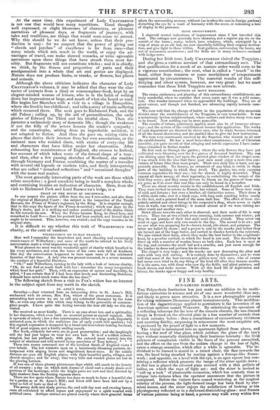FINE ARTS.
SUN-LIMNED PORTRAITS.
THE Polytechnic Institution has just made an addition to its multi- farious curiosities in science and art of one more wonderful than any, and likely to prove more attractive. It is a new photographic process for taking miniature likenesses almost instantaneously. This modifica- tion of the daguerreotype applied to portraiture is the invention of an American optician named WoLeorr. By substituting the speculum of a reflecting telescope for the lens of the camera obscura, the sun-limned image is formed on the silvered plate in a less number of seconds than it took minutes before : thus a resemblance of extraordinary vividness and unerring fidelity, surpassing in minuteness the most exquisite art, is produced by the pencil of light in a few moments. The visiter is introduced into an apartment lighted from above, and having a flat roof of blue glass, which subdues the glare of the sun's rays without materially diminishing their luminous intensity : the livid paleness of complexion visible in the faces of the persons assembled, and the effect on the eye from the suddeh change in the hue of light, cause a strange sensation, which after a while is agreeable. The in- dividual to be limned is seated in a raised chair, the face towards the sun, the head being steadied by resting against a forceps-like frame- work ; and opposite, on a level with the eye, is an open square box con- taining a reflector which presents the image of the sitter upside down : in this box is placed the silvered plate covered with a thin pellicle of iodine, on which the rays of light act ; and the sitter is invited to "call up a look" of pleasurable animation, which has scarcely time to relapse into dulness when the operator announces that the picture is completed. Before the visiters have ceased wondering at the magical celerity of the process, the light-formed image has been fixed by che- mical means, and the sitter enjoys the satisfaction of looking at his physiognomy reflected as in a darkened diminishing-glass : neat frames of various patterns being at hand, a person may walk away within five
minutes from the time of entering the blue chamber, with an effigy that no miniature-painter could rival in unflattering truth of character, or approach in force of effect and delicacy of execution, after repeated sittings and with laborious skill. "The limner's occupation's gone !" exclaims some alarmed por- trait-painter. Not so ; for the photographic likenesses are deficient in two of the most attractive features of a painted resemblance—colour, and vivacity. They are miniatures in chiaroscuro, adumbrating the forms of the face only : the expression is cold, severe, and gloomy. The intensity of the shadows gives greater massiveness to the features, and the sharpness of the lights more rigidity to the forms, than in the living reality ; the markings of the face are too strongly pronounced, while the light of the eye is deadened. The semi-transparent tints of the flesh, the fresh hue of the complexion in life, the variety of re- flected lights that give warmth and luminousness to the shadows in nature, and tend to soften the harsh lines and enliven the masses of form—these are all wanting : moreover, defects of facial conformation appear exaggerated, instead of being softened. Photographic portraits, therefore, will never supersede pictures ; but they will be valuable aids to the painter in preserving the predominant characteristics of the ori- ginal, and in giving breadth of effect to his arrangement of light and shade. They are inestimable as documents to refer to ; but not agree- able resemblances to contemplate : indeed, strictly speaking, the like- ness is not true, for the reasons we have stated.
If the charge be moderate—which it may be made—thousands will flock to the Polytechnic portrait-room, and the patentee, Mr. BEARD, will make a fortune. Photographic likenesses will be as numerous as silhouettes once were : the invention, instead of injuring the artists, will give them employment, and, what is better, tend to improve their art.



























 Previous page
Previous page